- Karsten Capion article on german coal decline in 2019 [Carbon Brief]
- Discussion on Lignite switch-off price
- Eckert Vera article on political and economic effects of coal decline and renewables increase [Reuters]
Karsten Capion article on german coal decline in 2019 [Carbon Brief]
- Read on Twitter:
- Read on CarbonBrief
@KarstenCapion @DanskEnergi @klimaradet in @CarbonBrief : Why German coal power is falling fast in 2019 (link: http://bit.ly/2M1IZ8j) bit.ly/2M1IZ8j
- Brown coal (lignite) ↘️ 14TWh (21%)
- Hard coal ↘️ 8TWh (24%) [44TWh (36%) in 5y]
- Power emissions ↘️ 20MtCO2 (19%)
(compared to eq. 2018)
Why?
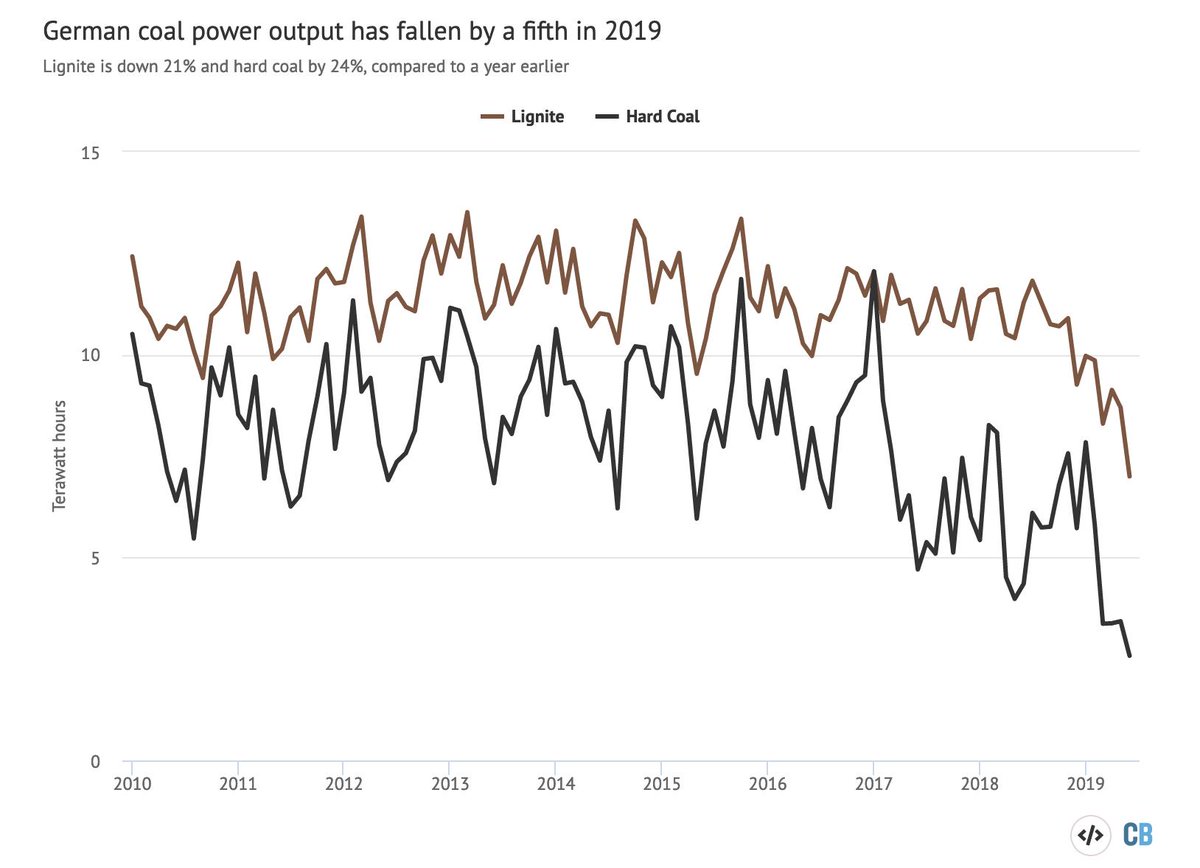
Snapshot of Germany’s power generation situation in EU
“Germany accounting for roughly a third of all electricity-related CO2 emissions in the EU : half of EU electricity generation from brown coal (lignite) + a quarter of the total for hard coal takes place in Germany”
Gap in production compensated with renewables / gas + lower demand
- Windfarms ↗️ 11TWh (19%)
- Solar ↗️ 1TWh (6%)
- Gas generation ↗️ 3TWh
- Demand ↘️ 9TWh (3%)
-> “wind is on track to become the single largest source of electricity in Germany this year, overtaking lignite”
Coal plants less active
Hard coal : running well below half it’s installed capacity https://t.co/aXXD9uLcSl

Brown coal (lignite)
“increase in the “drop-off price” - point below which plants are unable to operate without losing money - under which lignite plants significantly reduce their output, from about €10/MWh in 2017 to about €30/MWh in 2019.” https://t.co/g5Ueo9RzJm
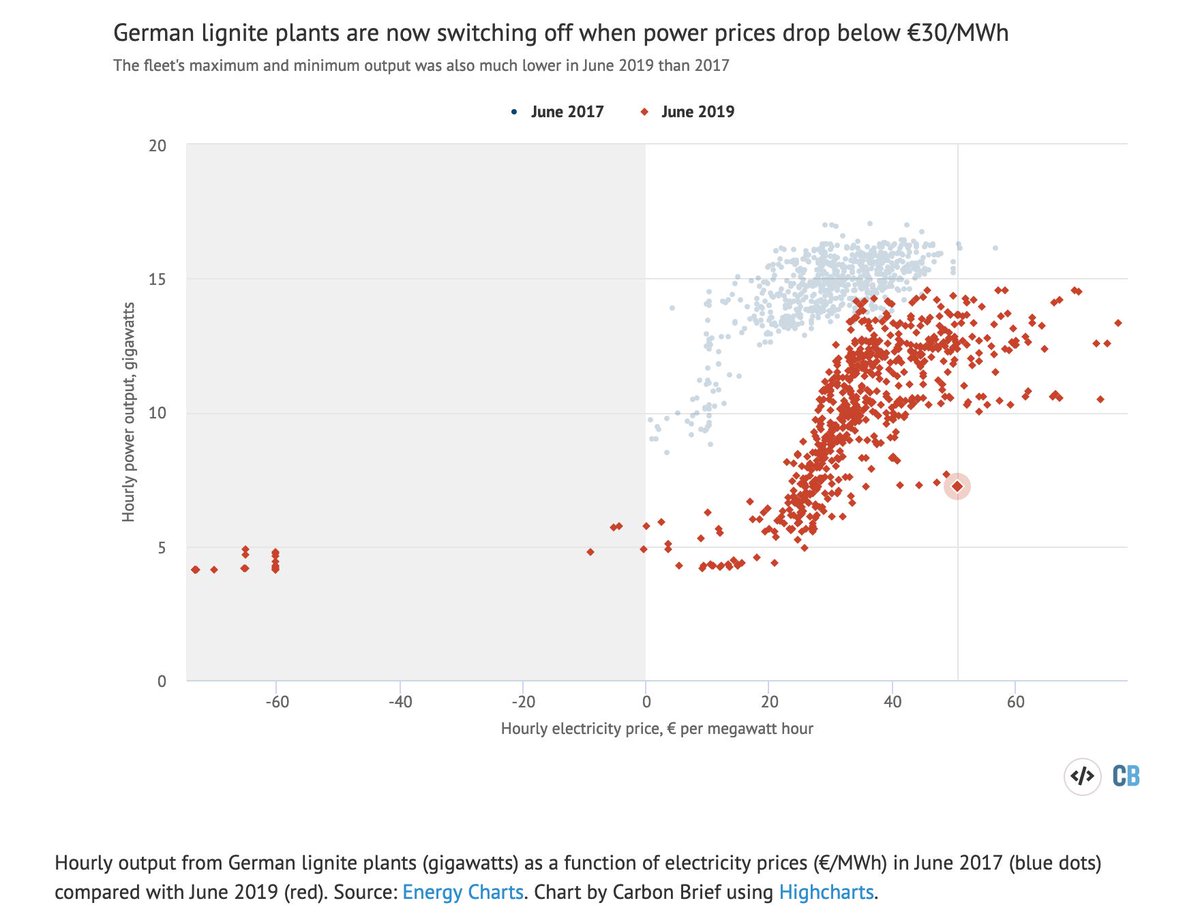
Some brown coal (lignite) plants have stopped generating over the past years, being kept open as “reserve”
-> Coal capacity does not automatically translate into emissions.
Cost of operation and emissions
-> In April, the cost of emitting CO2 (red line) overtook the cost of buying hard coal for a typical power plant (grey)
“Decline for hard coal generation despite falling fuel prices” https://t.co/dLTevnkPOG
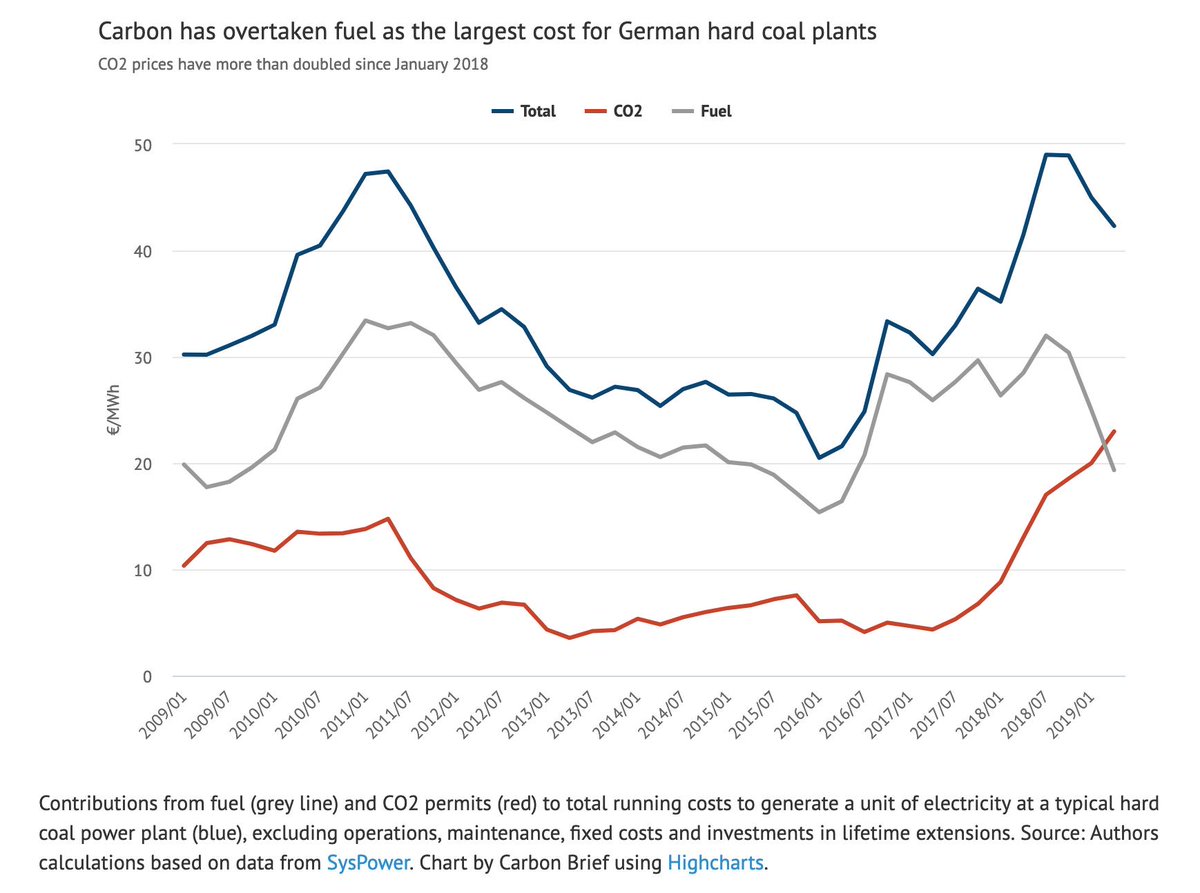
Hard coal
June 2019 : +- $50/tonne = < $66/tonne expected by the @IEA
With similar carbon price, hard coal costs likely to reach +- €50/MWh (up from closer to €40/MWh today)
= +- expected power price
=> low future profitability margins
Brown coal (lignite)
- In the past : less susceptible to green transition effects due to lower running costs
- This year : increased wind, lower demand + carbon price of 28€/tonne (up from 5€/tonne two years ago)
=> lower brown coal profitability https://t.co/xkq6Rcmnuc
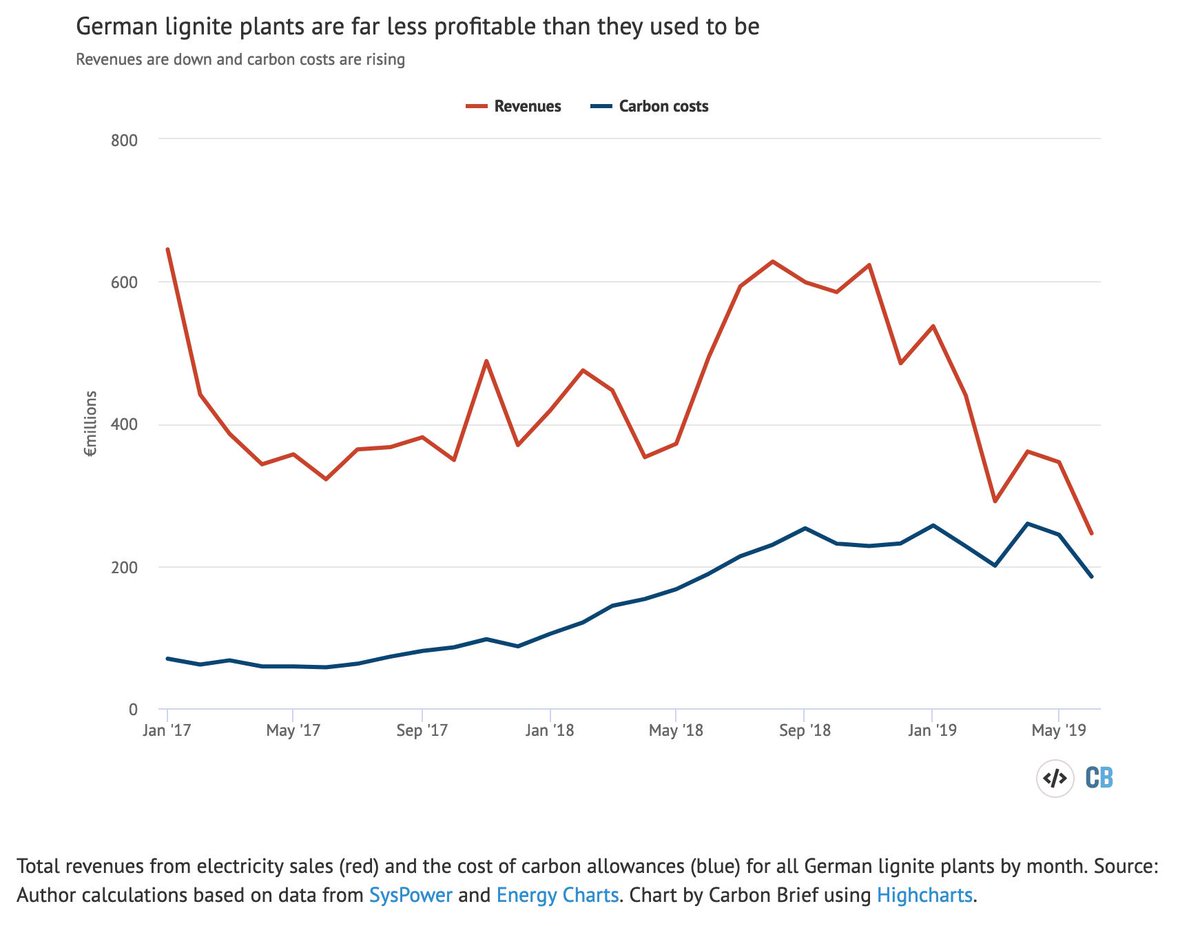
Carbon futures
“current market expectation is that lignite revenues will increase slightly over the next few years, with gas prices due to rise and competition from nuclear plants disappearing as Germany completes its phaseout of the technology by 2022.”
-> “lignite generation could rebound in the short term, as plants are expected to become cheaper to run (brown line) than their gas counterparts (blue line)”
-> “Despite potential rebound, price difference between running lignite and gas-fired power plant seems to remain small” https://t.co/ziG4GuCG8k
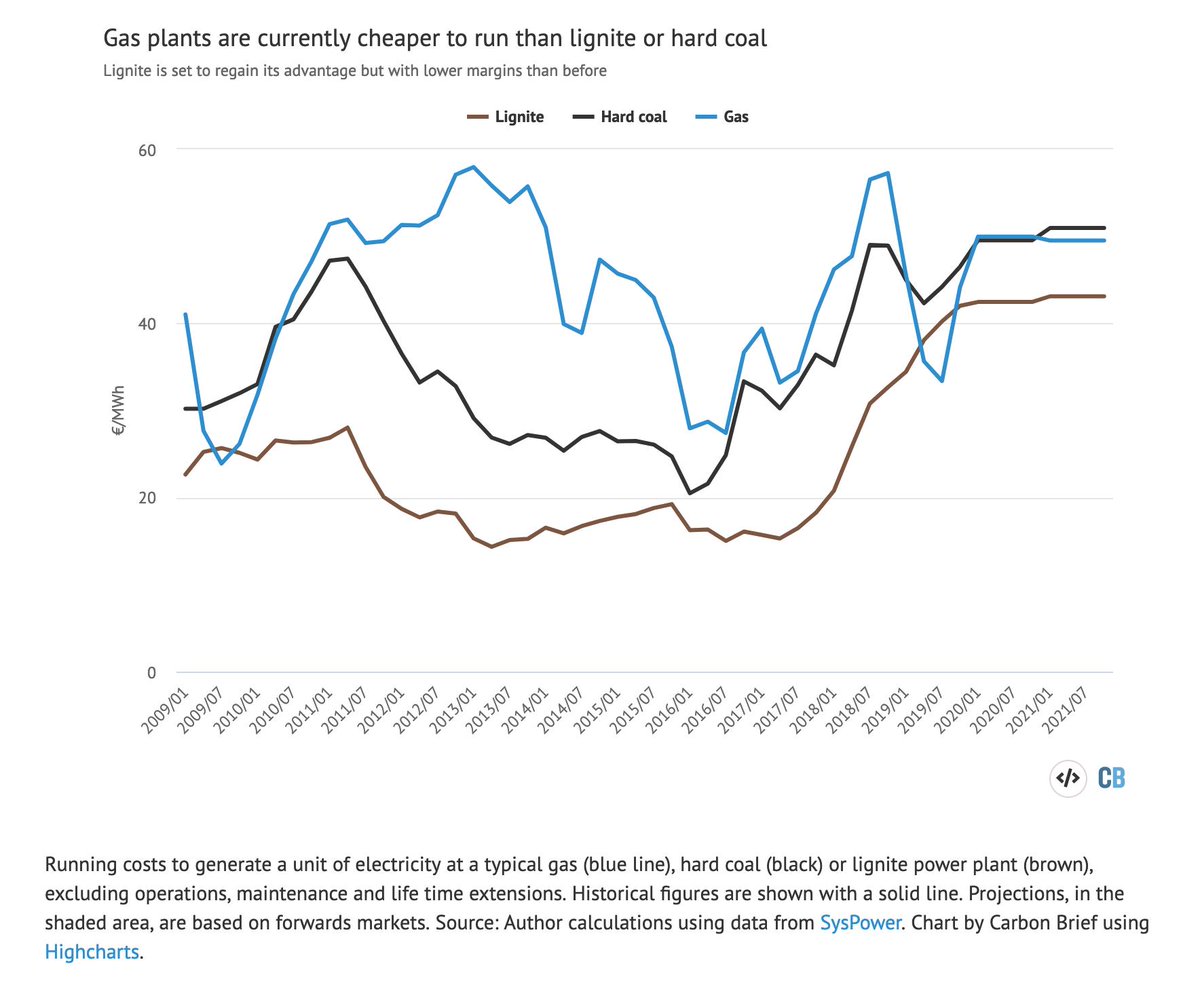
“Chart may even overstate the profitability of lignite plants, as it assumes a short-term running cost of €10/MWh. Longer-term running costs – on top of carbon costs – could be as much as €22/MWh, according to @ieefa_institute, citing figures from German lignite operator RWE.”
Reflections
-
Why are gas prices having such a strong rebound?
-
Why is the coal cost increase flattening? Is this a conservative ‘future market’ (in that case: do we need a market?) or is there a specific reason why this should or will be the case?
@KarstenCapion @nworbmot
Discussion on Lignite switch-off price
Great thread!
— euronion (@euronion42) July 19, 2019
Regarding lignite PP 'switch-off' price:
Could suggest an increase by 20 EUR/MWh for variable costs.
But w/ lignite @ ~0.4t-CO2/MWh & 28 EUR/t-CO2 we get +~12 EUR.
Any idea where the other ~8 EUR/MWh come from?
Probably not fuel costs, so why higher costs in ops?
How to get to the current 40€/MWh? What I understand is that the cost chart [https://t.co/yWubetb794] is still using a running cost (no CO2) of 10€/MWh, which is indeed argued to be 22€/MWh [https://t.co/BlQk8ESWvx]. No idea :) Maybe @KarstenCapion can shine light on this?
— Florian Dierickx (@FlorianDRX) July 20, 2019
Note that lignite power plants convert lignite to power at very far from 100 % efficiency.
— Karsten Capion (@KarstenCapion) July 20, 2019
Emission factor is between 1-1.2 ton/MWh.
28 €/ton -> 28-34 €/MWh carbon cost (+ 10-22 €/MWh operation cost).
Thanks! So the devil is in the emission factor.. :) It seems indeed that the German coal electricity emission intensity - dashed line in figure - is close to the global average mean of 1.13 ton/MWh (kg/kWh) [https://t.co/RRE5FIygYp] Using op. cost of 10 €/MWh one gets to +- 40. pic.twitter.com/BoiZniMIdW
— Florian Dierickx (@FlorianDRX) July 20, 2019
Yes. Have a look here. Short run operational costs (excluding carbon) may be just 5 €/MWh. https://t.co/yJdjXvyhbd
— Karsten Capion (@KarstenCapion) July 20, 2019
Eckert Vera article on political and economic effects of coal decline and renewables increase [Reuters]
- Read on Twitter:
- Read on Reuters
@EckertVera @Reuters : Does renewables pioneer Germany risk running out of power? https://reut.rs/2LZX2v6
/thread
Short answer: no, if we manage the transition intelligently
Situation and foresight
Expected 1/5th decrease in conventional power capacity by 2022
12.5GW ↘️ coal capacity 10GW ↘️ nuclear power
leaving 80GW conventional capacity
= still be nearly enough reliable capacity to meet the country’s peak demand of +- 82GW
“one-for-one match of supply & demand is unnecessary because overcapacities of 80/90 GW in the European region provided some leeway for imports into Germany” @peteraltmaier
“supported by environmental campaigners who say some energy producers playing up the threat of blackouts”
Conflicting interests and arguments in a battle for coal closure compensations
“They want to build up pressure to receive payments for capacities which otherwise would have no chance to come to play in the market.” @Oliver_Krischer
Utilities ask for compensation & guarantee
- @RWE_AG : 1.5 billion EUR/GW
- @trimet_se Philipp Schlueter: “Early exit from coal-to-power generation fills us with great concern”
- NHY.OL : “we can only go without conventional energy once renewables offer reliable supply”
European Transformation
“Over the next 10 years, coal-fired and nuclear power plants with a total capacity of around 100 GW will be shut down in Europe, equivalent to Germany’s thermal power capacity alone, according to grid operator data. “
“To counter this, hundreds of gigawatts of offshore wind are planned to line European coastlines by the end of next decade, according to the EU’s green expansion plans. “
“Most industry experts agree the transition is needed to combat climate change, and that within 10 or 15 years there will be substantial renewable generation to provide reliable cover for the continent, on the road to carbon neutrality by 2050. “
“German output accounts for around 20% of the European Union’s electricity, with France another 17%, according to figures from Eurostat, the EU statistics office. “
@Fabian_Joas @AgoraEW “it would be a difficult road […] to meet its goal of abandoning conventional energy in coming decades”
-> “But we will be able in the long run to operate a power system based nearly fully on renewables. Everyone who understands the matter agrees on that”